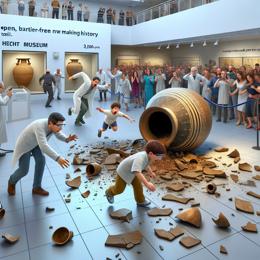Image created by AI
Archaeological Breakthrough: 115,000-Year-Old Human Footprints Discovered in Saudi Arabia
In a groundbreaking archaeological find, scientists have uncovered 115,000-year-old human footprints at a site called "the trace" in northern Saudi Arabia's Nefud Desert, revealing new insights into early human life and migration. This discovery, made in a prehistoric mudhole amidst hundreds of animal tracks, not only pushes the boundaries of our historical knowledge but also illustrates the unique conditions necessary for the preservation of such ancient human marks.
Located deep within the desert, the site was unearthed in 2017 when natural erosion revealed these hidden treasures. The preservation of the footprints is attributed to the specific qualities of the ancient mud, which, under normal conditions, would obliterate such prints within days. A detailed analysis by scientists showed that these seven hominin footprints align with the timeline when Homo sapiens started expanding into the Levant and Arabia, from around 130,000 to 80,000 years ago.
This era precedes a significant ice age, suggesting these footprints could represent a moment in time right before dramatic climate changes. The Alathar lakebed, where these footprints were found, likely served as part of an ancient migration route—a verdant stopover in a harsh desert, where large animals and early humans found respite and essential resources such as water.
Interestingly, despite the proximity to various animal tracks, there is no evidence of hunting—no tool marks on bones or other typical signs of prehistoric human habitation. This detail leads researchers to believe that the site's use by early humans was transient, likely driven by the necessity for freshwater during a period of extreme aridity.
This site provides unparalleled insights into the movement and survival strategies of early Homo sapiens. The absence of overlapping tracks or later sedimentary layers covering the footprints until their recent exposure suggests a brief, unshared usage of this point in the landscape, offering a rare snapshot of human life during this ancient period.
The discovery at Alathar not only adds a significant chapter to the story of human evolution and migration but also highlights the serendipitous nature of archaeological discoveries, where elements like mud and climate work together to preserve moments of the ancient past that might have otherwise been lost forever.










